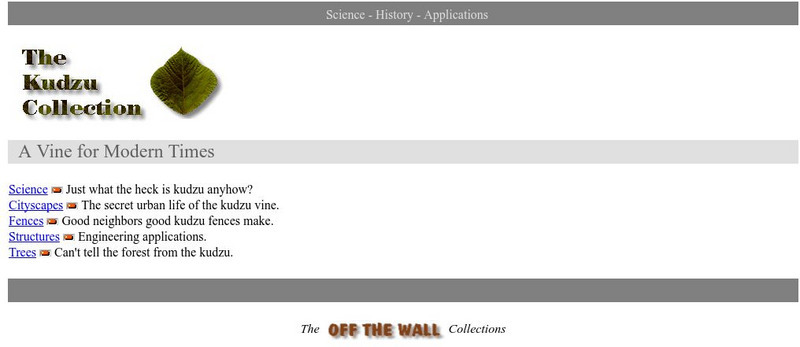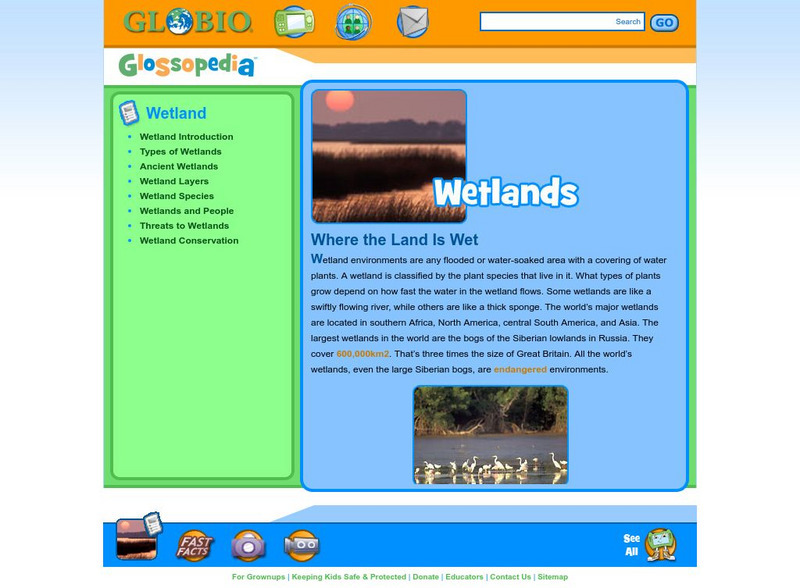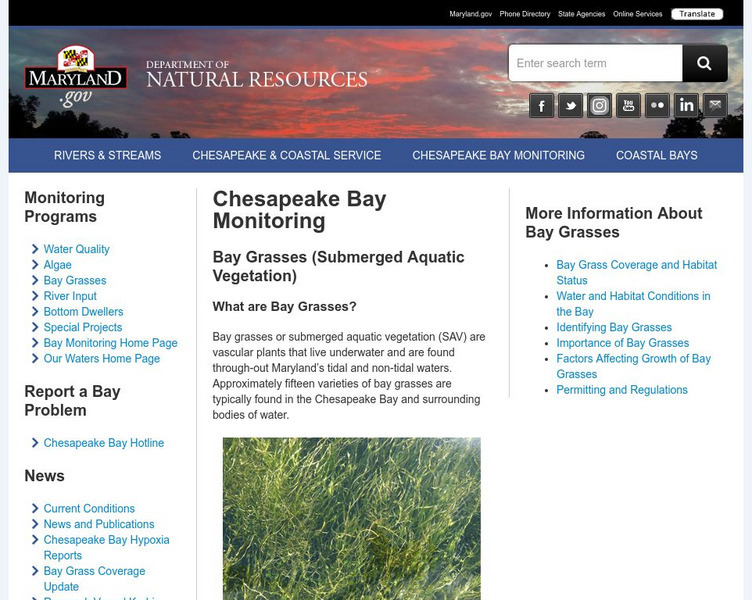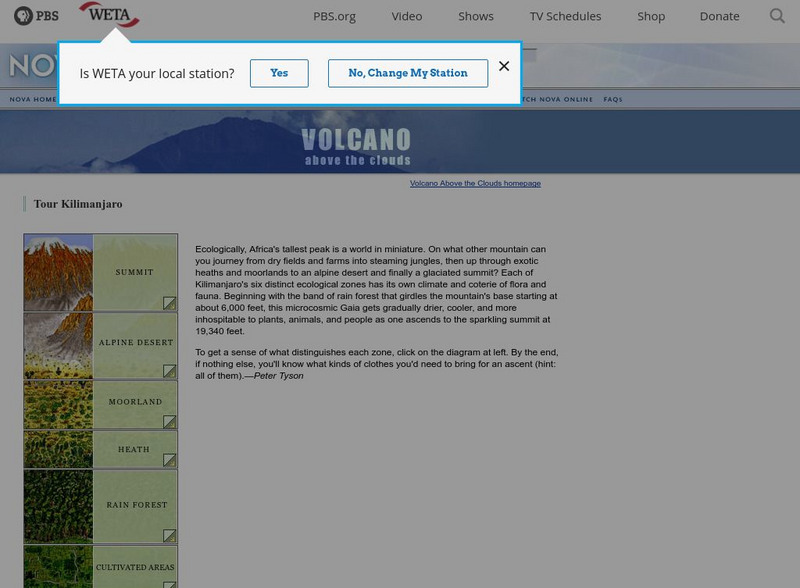PBS
Nh Pbs: Nature Works: Wetlands
Did you know that wetlands are frequently used as resting stops for migrating birds? This is just one of the many interesting facts found within this educational resource. This site features information on the characteristics, types,...
University of California
Ucmp: Yesterday's Trees Today's Horsetails
Berkeley offers a brief introduction to these Sphenophyta. At the bottom of the page, you can go to sections such as fossil record, ecology/history and systematics.
BioEd Online
Bio Ed Online: Living Things and Their Needs: We Need Water
This instructional activity focuses on living things' need for water. Students make lemonade and learn that water can be found in liquids other than a glass of water, and is also found in plants. The instructional activity can be...
Other
University of the Western Cape: Department of Biodiversity: Abiotic Components
The Department of Biodiversity at UWC presents the impact different abiotic components on plants and animals. Some factors are light, temperature, and wind.
Khan Academy
Khan Academy: Intro to Photosynthesis
Discussion of the conversion of light energy to chemical energy through the life-sustaining process of photosynthesis. Explores the reactions of photosynthesis, where they take place, and their ecological importance.
Canadian Museum of Nature
Canadian Museum of Nature: Native Plant Gardening
Plants native to Canada that would do well in small, ecologically friendly gardens are presented here. There are several plants each for ponds, meadows and woodlands. Each plant has a popup window with facts about it.
Environmental Education for Kids
Eek!: Habitats
Take a look at some of the different habitats that are home to many plants and animals including black bears, owls and various species of birds.
US Environmental Protection Agency
Epa: Wetlands and Nature
This concise site discusses the fact that wetlands are among the most productive ecosystems in the world, play an integral part in the ecology of the watershed, and also have a role in atmospheric maintenance.
BioEd Online
Bio Ed Online: Needs of Living Things: Pre Assessment
This is a pre-assessment to be done at the beginning of a unit on the needs of living things. Students draw themselves and what they need to survive. The lesson can be downloaded in PDF format.
BioEd Online
Bio Ed Online: Needs of Living Things: Post Assessment
A post-assessment at the end of a unit on the needs of living things. The lesson materials can be downloaded in PDF format.
ibiblio
Ibiblio: The Kudzu Collection (Photographs)
A fascinating Ibiblio.org collection of Kudzu photos in a variety of southern habitats. There is a short report on the history and botany of this vine.
abcteach
Abcteach: Ponds
[Free Registration/Login Required] The abcteach directory contains sample pages from their pond unit for non-members. Handouts are in PDF format.
Other
Forest and Bird: Kiwi Conservation Club
A place for learning about New Zealand's wildlife and wild places, Kiwi Conservation Club is home to a range of activities and glossy, illustrated pages on topics of interest to young naturalists. Also view the latest issue of Wild...
PBS
Nova: Stories in Amber
Like a time machine, amber fossils take us back in the earth's history to discover the plants, animals and ecological relationships of prehistoric ecosystems. This resource has several interesting pictures of a variety of Dominican...
Globio
Glossopedia: Wetland
Wetlands are an integral piece of Earth's ecology. Wetland structure is described as well as their role in the health of plants and animals. Issues concerning destruction and preservation efforts also discussed.
University of Guelph
Introduction to Invertebrate Biodiversity: Fungi
Find out more about fungi when you check out this comprehensive site. This resource provides an introduction and information on morphology, reproduction and the importance of fungi. Don't miss out on this fascinating source.
Other
Maryland Dnr: Chesapeake Bay Monitoring: Bay Grasses
This resource provides information about the marine grasses found in the Chesapeake Bay. Click on adjacent links to learn about their habitat, how to identify them, and why they are important.
University of Florida
South Florida Aquatic Environments: Florida Keys: About the Keys
The Florida Museum of Natural History offers an excellent review of the reefs, mangrove and seagrass habitats of the Florida Keys. Spend some time learning about this unique location.
Other
Missouri Conservationist Online: Missouri Cave Life
Excellent article describing a trip inside a cave. The article discusses the cave habitat and changes that occur as you go deeper into the cave. Includes interesting photographs.
Smithsonian Institution
Smithsonian Environmental Research Center: It's All in the Watershed
Learn about your ecological home on this site. The nation shares the Chesapeake Bay watershed, our ecological home. Most stories on this site focus on separate plants and animals, but together, these stories literally show a web of life.
Environmental Education for Kids
Eek!: Evergreens
Site chronicles Wisconsin's Evergreen and Conifer trees. There are descriptions of the various tree types. Additionally, site details the uses of these trees in nature. Ideal for grades 4-8.
PBS
Nova: Tour Kilimanjaro
Experience six different ecological zones as you climb Mt. Kilimanjaro. Pictures of plants living in each of the zones are also part of this virtual tour of the mountain.
Cornell Lab of Ornithology
Habitat Network: Habitat Feature: Evergreens
Learn how evergreen plants, both trees and shrubs have important roles to play in landscaping- from aesthetic to ecological.
Nature Conservancy
Nature Conservancy: Planet Earth: Oceans and Coasts
Compilation of the Nature Conservancy's content about the ecology of oceans and coasts. Emphasis is on the biodiversity of these habitats and the human impact on the animal and plant life that live in our oceans and on our coasts.




















